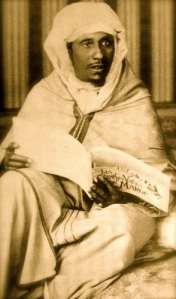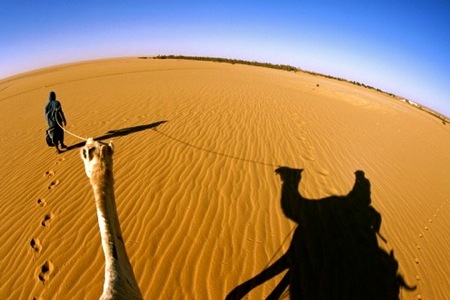Posts Tagged ‘Camel Trek’
How does the Ramadan fast affect tourists traveling to the Imperial Cities, the Sahara Desert and other regions of Morocco during this high holy holiday? Can tourists eat or drink in public during Ramadan? This article should clear up the confusion on this issue for tourists, to explain the most polite solutions for tourist behavior at this time, and to assure tourists that there is no problem with them visiting Morocco during Ramadan. Because the Islamic calendar is lunar, holidays such as Ramadan advance by approximately ten days with each subsequent year. This means that Ramadan makes a cycle through the entire calendar of twelve months each twenty-some years. This year, Ramadan started on August 12th, 2010 in Morocco. The fast presently starts in Morocco at approximately 4:30 AM, and ends in the evening at approximately 7:30 PM.
For anyone interested in touring Morocco’s kasbahs or ksars, I highly recommend starting with Kasbah Taourirt, the Pasha Glaoui’s former palace in Ouarzazate. Kasbah Taorirt was built by the Pasha Glaoui. Its location was strategic for trading routes and in the 1930’s when the Glaoui ruled the South was then considered one of Morocco’s largest Kasbahs. Kasbah Taourirt was one of the places Glaoui kept his slaves. As a Moroccan traveler you can explore its nooks and crannies to discover its history and often local female painters who sell their art inside as well as the many quality silver shops just steps outside the Kasbah.
Pasha T’hami Glaoui was the most powerful man in Morocco between 1953 and 1956, in addition to being one of the richest men in the world at that time. The title Pasha means Governor. Glaoui was the Pasha of Marrakesh (since 1912), Ouarzazate, and most of the Moroccan south during the time Morocco was under French rule. The most important Kasbahs’ in Morocco that were occupied by the Pacha Glaoui during his reign and are frequented by Moroccan travelers today are Kasbah Taouirt, located in the center of Ouarzazate, Ait Benhaddou, located 15 kilometers outside Ouarzazate and Kasbah Telouet which sits in the village of Telouet nestled outside the Onilla Valley.
Are you wondering what there is to see and do in Ad Dakhla, Morocco besides kitesurfing? Dakhla also referred to as Ad Dakhla is a fishing and surfing paradise which was once the capital of the Spanish province of Rio de Oro. Dakhla or Ad Dakhla is one of the ultimate places to go where you can witness unspoiled Sahara Desert scenery. Visiting Dakhla is ideal for Moroccan travelers who want to get away from the crowds and visit a place where it is still possible to see the authentic nomad lifestyle nearby. Another place in Morocco where it is possible to see the authentic Nomad lifestyle is in the Bouthgrar region near Mount Mgoun which is often referred to as the Valley of Nomads. The Valley of Nomads can be visited from en route from Ouarzazate when passing the Valley of Roses.
Berber Tours to Morocco are authentic way to Discover a Berber Village, visit ancient kasbahs and camel trek in the Sahara Desert. Discover a Berber Village is a Southern Morocco Cultural Tour that is an EXCLUSIVE Travel Exploration Morocco. Discover a Berber Village is a historical journey where Moroccan travelers can have an up close and authentic experience in a Moroccan, Berber Village while visiting the Ouarzazate and Zagora regions of Morocco. When traveling to Morocco, a Morocco vacation is not complete without visiting Morocco’s indigenous people and discovering its Berber Villages. A Berber Tour to Morocco is the most important Moroccan voyage for those who are interested in Morocco’s history and old world traditions.
Upon first sight of the Moroccan Sahara Desert, one can wonder if it is a grain of utopia or perhaps a miracle created by god. For those who are not believers then let’s just say that one must, in their lifetime have tea in the Sahara. The Sahara desert is itself a character in The Sheltering Sky a novel written by the prolific writer and composer Paul Bowles. For centuries explorers have been seeking to discover the Moroccan Sahara. Almost a century ago, a young administrator in the British Colonial Service decided to take 1,500-mile adventure trek across an ancient, deadly slave route in Africa’s Sahara desert.Hanns Vischer then published a book about this British Colonial’s journey, across the Sahara desert and went on to become one of the most famed explorers of his era.






